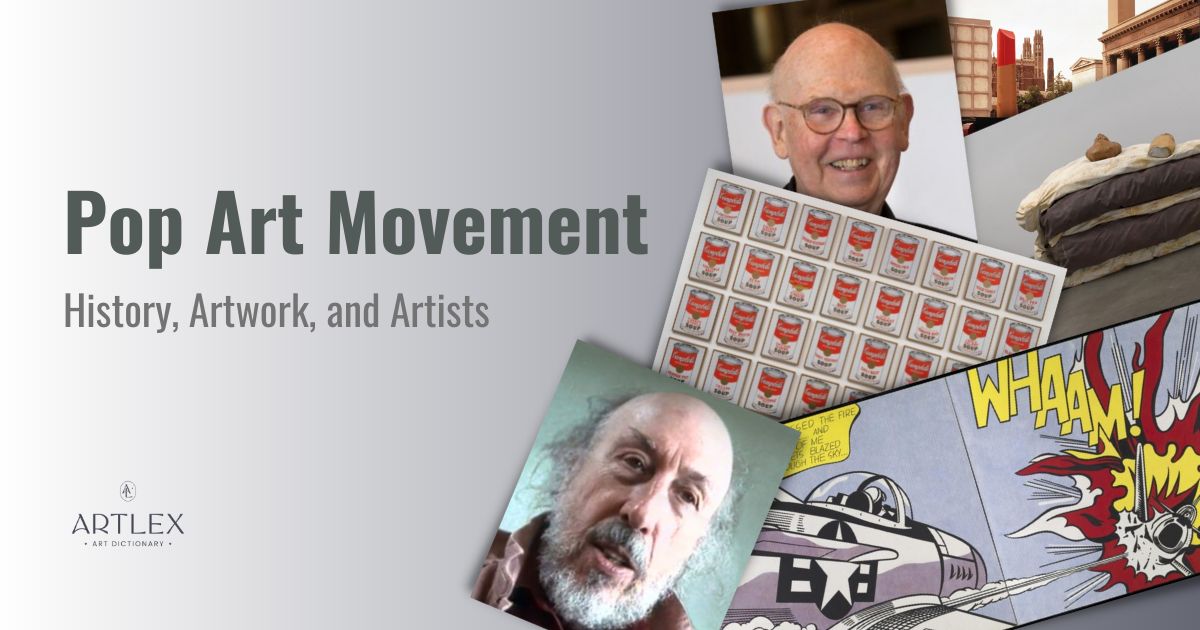
Art was an art movement that centered on popular culture, consumer culture, and mass media. Pop Art began in the 1950s in the United Kingdom, and spread to the United States in the 1960s. It was a reaction to the preceding art movements such as Abstract Expressionism, which was highly personal and philosophical, and a reaction to the elitism of both traditional and modernist “high art.”
Pop Art artists draw inspiration from the dynamic consumer culture, using and manipulating images from advertising, newspapers, comics, product labeling, television, and Hollywood movies.
The leading names who shaped the movement were Eduardo Paolozzi, Peter Blake, Claes Oldenburg, Andy Warhol, Roy Lichtenstein, Robert Indiana, Robert Rauschenberg, among others.
What is Pop Art?
Pop Art was an art movement based on American popular culture, consumer culture, and mass media, especially as a ironic reaction to “high art” values. Pop art was founded in the 1950’s in Britain, and spread to the United States in the 1960s.
British Pop art played into the fantasies of American consumerism, portrayed as British artists viewed it from afar. The British were still struggling from the damages of war incurred a decade earlier. Commercialism, encompassing colorful objects from everyday life became part of the art.
One of the founders of Pop Art, Richard Hamilton, described Pop art by saying, “Pop art is popular, transient, expendable, low-cost, mass-produced, young, witty, sexy, gimmicky, glamorous and big business.”
Pop art was about high art and low art merging together. It was heavily influenced by popular culture. It appealed to the cultural youth movement. Everyone was enjoying fast food, fast cars, and color television for the first time. New music was part of this generation. British pop bands such as The Beatles and The Rolling Stones were dominating the music scene. So was Elvis Presley. Movies and comic books were also inspirational.
History of Pop Art
Pop Art originated when the art centric club called Independent Group formed in London, in 1952. The Independent Group was comprised of artists Richard Hamilton and Eduardo Paolozzi, along with architects Alison and Peter Smithson. There were also two art critics in the group, Reyner Banham and Lawrence Alloway.
Discussions among the members of the Independent Group were rich in popular culture and included topics not often represented in art at the time including, Western movies, science fiction, advertising and the new conveniences brought forth by household appliances.
The works of Richard Hamilton and Eduardo Paolozzi referenced American consumerism through mass-produced items. These artists were among the first to use mass media imagery.
The New York Pop art scene was influenced by the Neo-Dada movement such as artists Jasper John, who combined the abstract painting with recognizable images of everyday life. This included numbers, letters, and handprints. Robert Rauscherberge was busy combining oil painting with found objects.
By the 1960s, Warhol made the transition from painting by hand to silk screen. Repetition in his work represented both the mass-produced consumer goods and celebrity. It also the emphasized continual imagery of what was seen through the family television, as well as in print. Meanwhile, Roy Lichtenstein was most influenced by images in comic books.
Pop art caught on in Los Angeles, with the 1962 exhibition Pop Art, New Painting of Common Objects, at the Pasadena Art Museum. On display were works by Andy Warhol and Roy Lichtenstein. Artists living and working in Los Angeles included Robert Dowd, Joe Goode, Phillip Hefferton, Ed Ruscha, Wayne Thiebaud. Geographical references to Los Angeles were depicted through surf boards and motorcycles in the work of Billy Al Bengston. In this way Pop Art also became regional.
For more information, see our Brief Pop Art History Guide.
Why is it called “Pop Art”?
The term “Pop Art” is usually credited to the British art critic and curator Lawrence Alloway to point out that art has a basis in the popular culture of its time. As the decade progressed, American artists took the lead in the movement that would reach its peak in the 1960s.
Like most all art, the origin of the name is difficult to pinpoint. Terms are generally applied to art after a trend is noted, and usually not by the artists creating it. Some art historians attribute it to Alloway, yet letters written by Hamilton, and the Smithsons also included the term. The word ‘Pop’ first appeared in Paolozzi’s collage, I Was a Rich Man’s Plaything (1947)
Characteristics of Pop Art
The characteristics of Pop art include:
- A merging of high art and culture/fine art and low art
- A belief that everything subject can be used in art
- Incorporated popular culture
- Celebrity references to rock stars, movie stars and politicians
- Images of American consumerism
- Mass production of consumer products
- Everyday images of people, consumer goods, home appliances
- Bold colors from the primary and secondary color wheel
- Hard edges
- Monumental images
- Ben-Day dots just like comic books used
- Pulp culture
- Incorporation of signage and logos
- Geographical reference through depiction of surf boards and motorcycles
- Use of new mediums such automobile paint
- Generally devoid of emotion/ viewer is just an observer
For more information, see our full guide on Pop Art Characteristics.
What are the Different Types and Styles of Pop Art?
- Painting using different mediums that were not generally associated with fine art
- Collage using new and vintage photography, images from magazines and newspapers
- Screen print to mass produce images
- Sculpture including objects made with fabric
- Paper maches
- Plaster models
- Soft form fabrics
Pop Art Artists
Some of the most notable Pop art artists include British artists Richard Hamilton, Eduardo Paolozzi, and Peter Blake, as well as American artists Andy Warhol and Roy Lichtenstein.
Richard Hamilton

Richard Hamilton (1922-2011) was the founder of Pop art. The artist used visual juxtapositions to capture the energy of the new home electronic television sets. He was also credited with merging art with consumerism, which would become a foundational element within the Pop Art Movement. His work often contains the element of pictures set within other pictures.
Read more about Richard Hamilton.
Eduardo Paolozzi
Scottish Pop artist Eduardo Paolozzi (1924-2005) was one of the pioneers of Pop art. He was known for his graphic works, collages, sculptures, and mosaic murals. Former Beetle Paul McCartney chose Paolozzi to create cover art for his album Red Rose Speedway.
Read more about Eduardo Paolozzi.
Peter Blake
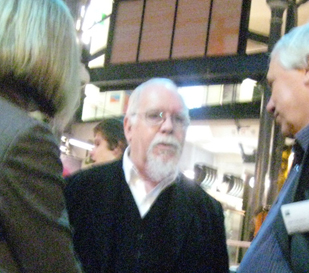
Peter Blake (1932-) became attracted to the optimism of colorful advertising, magazines, and poster, after the onset of the war in Britain. Initially trained as a graphic artist, Pop art was perfect movement for Blake to blend his commercial art training with fine art. His work often contains the element of pictures set within other pictures. The artist is best known for designing the cover or the Beatles’ album for Sgt. Pepper’s Lonely Hearts Club Band (1967).
Read more about Peter Blake.
Andy Warhol
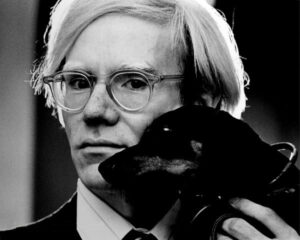
American Pop artist Andy Warhol (1929-1987) worked as an illustrator for both consumer print magazines, as well as advertising. This inspired his art career that focus on commercial goods and celebrity. Other famous works by Warhol include repetitive silks screens of celebrities (such as Marilyn Monroe, Elizabeth Taylor, Mick Jagger, and Elvis Presley), a commentary on the frequency on which their faces were seen in mass media.
Read more about Andy Warhol.
Roy Lichtenstein
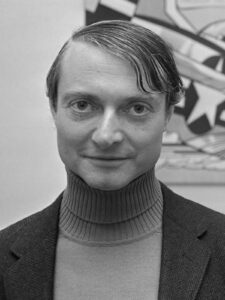
American Pop Artist Roy Lichtenstein (1923-1997) was most deeply influenced by comic books. Works appears in vivid color with dark black outlines. By adding Ben-Day dots to his canvases, he replicated a printing technique used in creating comic strip. The addition of thought bubbles employs deadpan humor.
Read more about Roy Lichtenstein.
Claes Oldenburg
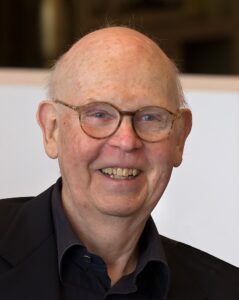
Claes Oldenburg (1929-) was born in Stockholm, Sweden, and moved to Chicago at the age of seven, where his father worked as a Swedish diplomat. The artist is best known for taking everyday objects and turning them into gigantic sculptures, with a sense of fun. His work can be found around the world, in United States, Europe and Asia.
Read more about Claes Oldenburg.
For other pop art artists, see our guide on Pop Art Artists and Female Pop Art Artists.
Pop Art Artwork
Examples of famous and notable Pop Art artwork include the following:
I Was a Rich Man’s Plaything (1947) Eduardo Paolozzi
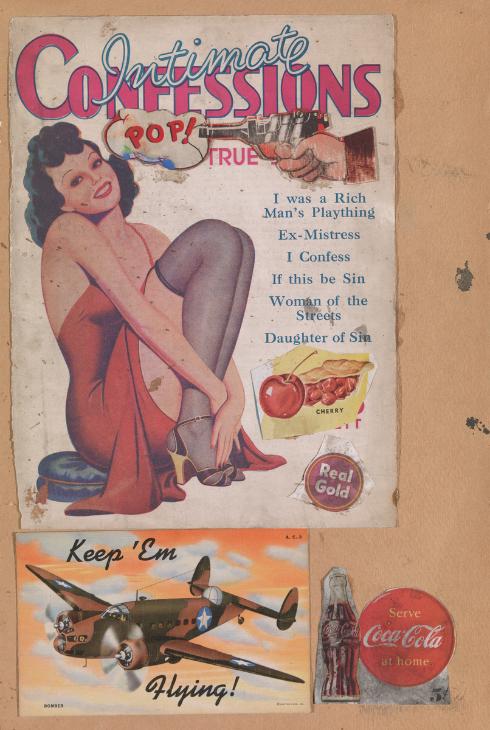
In this work, Paolozzi uses images from American magazines. The magazine entitled Intimate Confessions, was given to him by a Paris-based, American ex-soldier. On the cover was a pin-up girl illustration, which Paolozzi used as a central image. A Coca-Cola logo, a cherry pie and a World War II bomber also appear in the collage. A man holding a gun with the word POP!
Just what makes today’s homes so different, so appealing? (1956) Richard Hamilton
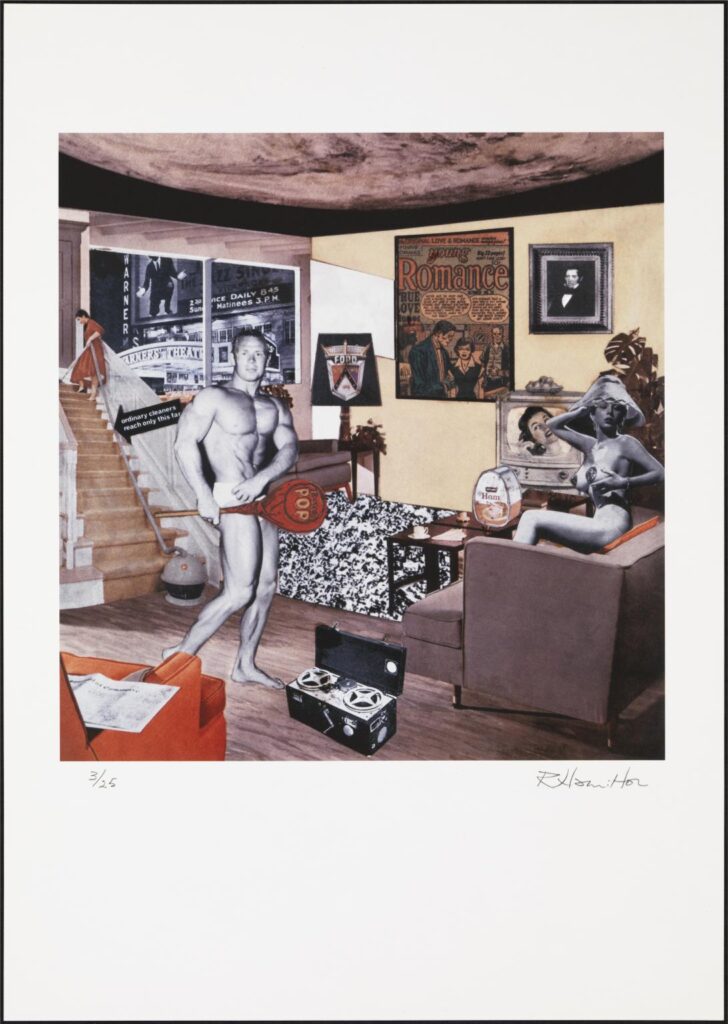
This work is often described as the first genius work of Pop Art. Using images cut from American magazines the collage illustrates the new, contemporary Adam and Eve, within the confines of a home that worships consumerism. Here a naked, muscular Adam hides his groin behind a huge lollipop. Eve wear pasties and a lampshade.
Swingeing London 67 (f) Richard Hamilton
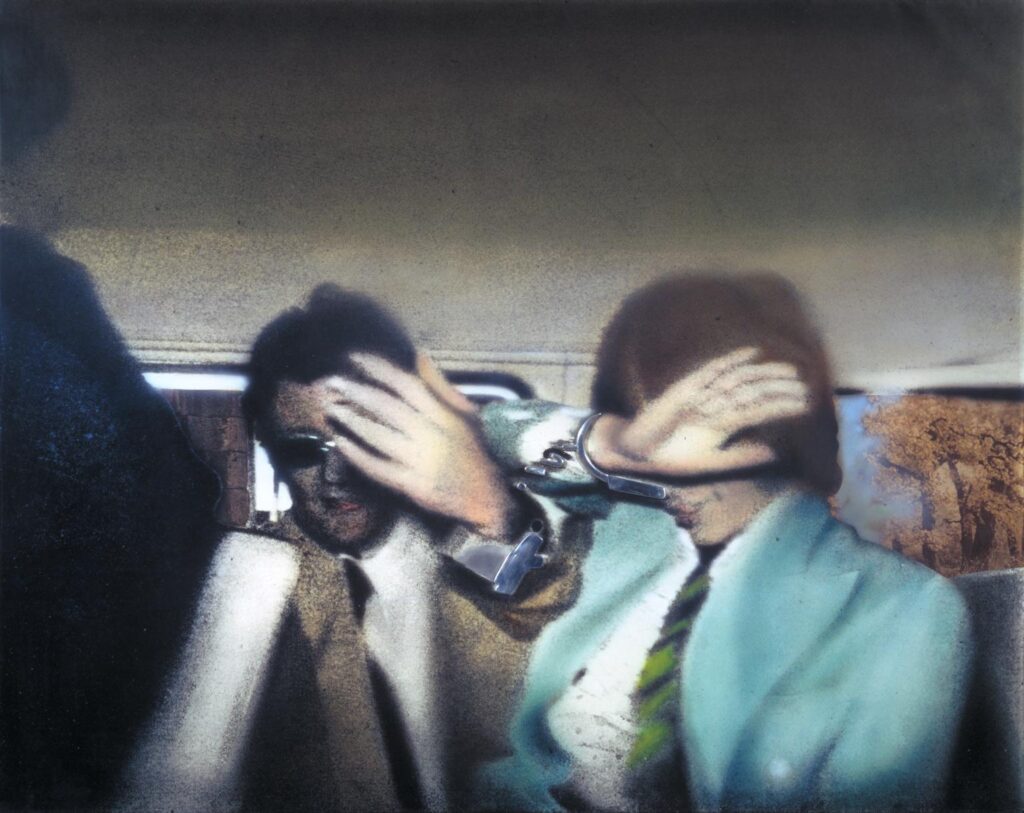
Using acrylic on canvas, Richard Hamilton recreates a newspaper image of Mick Jagger and Keith Richards from the Rolling Stones. What make the work of particular interest is that is illustrates the band mates under arrest, for drug possession. Both are handcuffed and hiding their faces. The title is a play on Swinging London, the youth movement of the time. It a counterculture to the traditions the public upheld, and the painting shows the effect. In British slang swingeing means severe. Collection of the Tate, in London, United Kingdom.
On the Balcony (1956-1957) Peter Blake
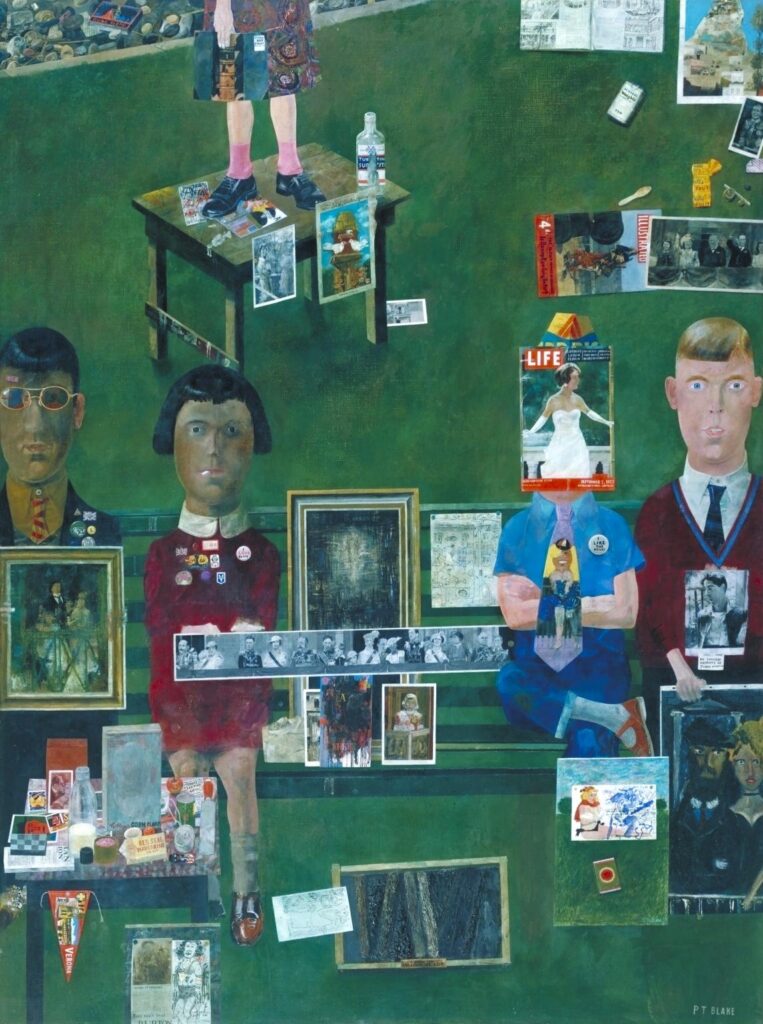
This work by Peter Blake combines images of people, with symbols of lifestyle all around. There are images from popular cultures, as well as fine art, blurring the boundaries. While Blake devised the art to look like a collage, the work is comprised of oil on canvass. Collection of the Tate, London, United Kingdom
Campbell’s Soup Cans (1962) Andy Warhol
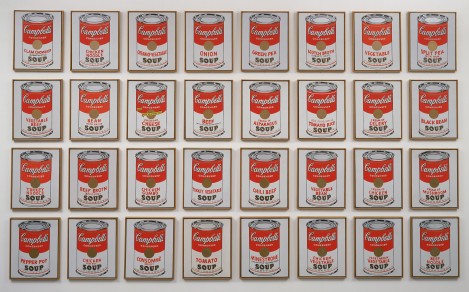
One of Andy Warhol’s most famous works is Campbell’s Soup Cans. The work is comprised of illustrations of his favourite childhood soup, set in 32 posters, using synthetic polymer paint on canvass. Each poster represented a different flavor and were exhibited horizontally. Warhol’s work brought on a public debate, as to what could be considered art.
Elvis I and II (1963-1964) Andy Warhol
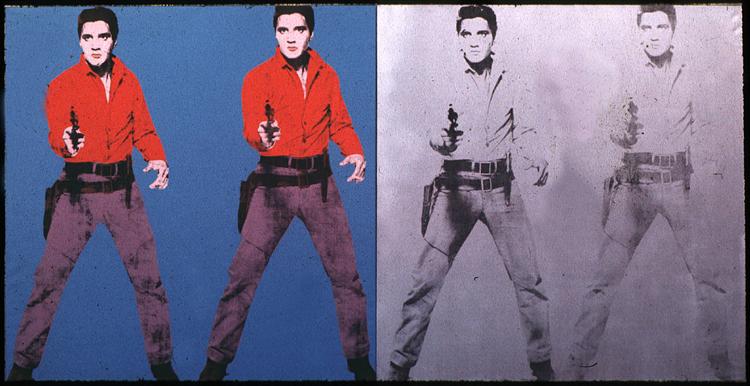
Elvis I and II, by Andy Warhol is a double artwork on two canvases. One in blue acrylic on linen, with silkscreen ink. Here Elvis appears in bold purple pants and a red shirt. The silver canvass uses spray paint and silkscreen ink to portray images that appear to look like an image in newspaper print. This work was mass produced.
Look Mickey (1961) Roy Lichtenstein
Roy Lichtenstein’s Look Mickey, is an oil on canvass image that focuses on Mickey Mouse from Walt Disney’s famous cartoons. Here is Mickey is having a laugh at the expense of her famous friend Donald Duck. The friends are fishing, and the duck say, “Look Mickey, I’ve hooked a big one!” Mickey suppresses a laugh, as the duck has only hooked his own backside. The artist took the image directly from the 1960’s children’s book Donald Duck: Lost and Found. The work hangs in the National Gallery of Art, in London, United Kingdom.
Whaam!(1963) Roy Lichtenstein
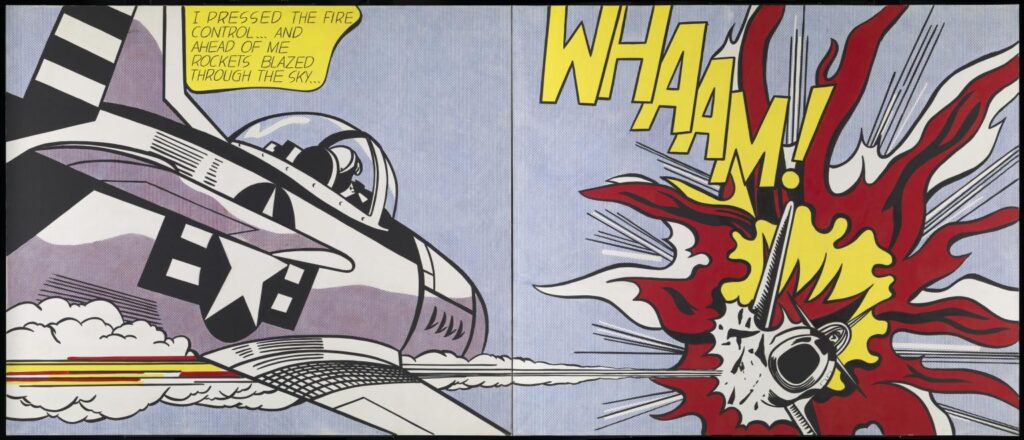
One of Lichtenstein’s comic book takes on real life events is Whaam! This painting depicting the air force is comprised of two large panels. In the thought bubble it says, “I pressed the fire control… and ahead of me rockets blazed through the sky.” The work uses acrylic paint and oil paint on canvas. It hangs at the Tate Modern, in London, United Kingdom.
Drowning Girl (1963) Roy Lichtenstein
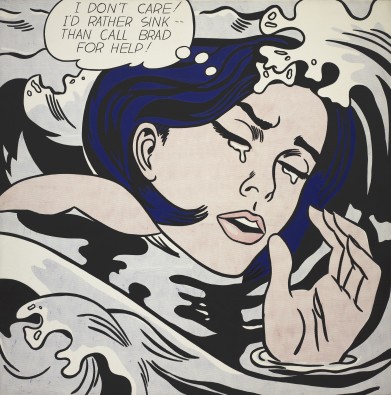
At the MoMA in New York hangs Drowning Girl, a work using oil and synthetic polymer paint on canvas. Without care to her perilous situation, and engulfing waves, her thought bubble says, “I don’t care! I’d rather sink—then call Brad for help!” Here, Lichtenstein used an appropriated image from a romantic comic book called Secret Hearts, published by DC Comics in 1962. The #83 edition from which the work was taken, was illustrated by artist Tony Abruzzo. While the image has been cropped, and the words changed, art experts debate how different the work is from the original image.
Floor Cake (1962) Claes Oldenburg
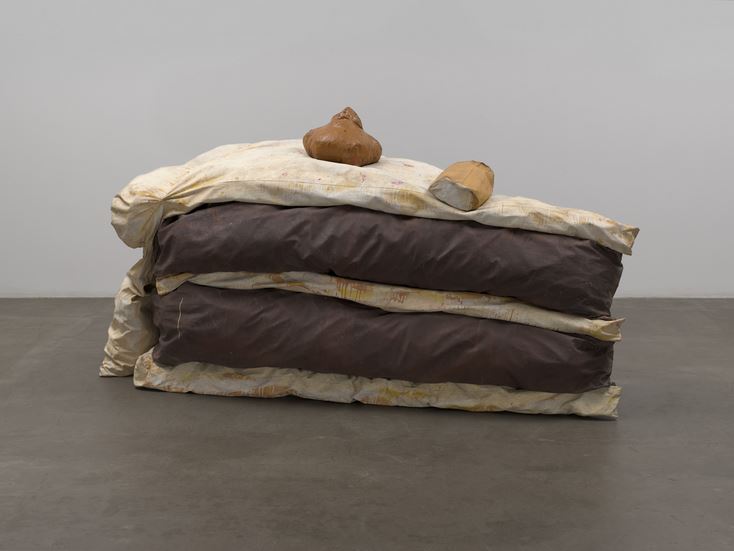
Floor Cake, a gigantic triangle of cake measuring nine feet long and five feet high. The fabric layers were assembled in stages, with empty ice cream cartons and foam rubbers inside, to give the work volume. Painted elements resemble frosting.
Lipstick (Ascending) on Caterpillar Tracks (1969) Class Oldenburg
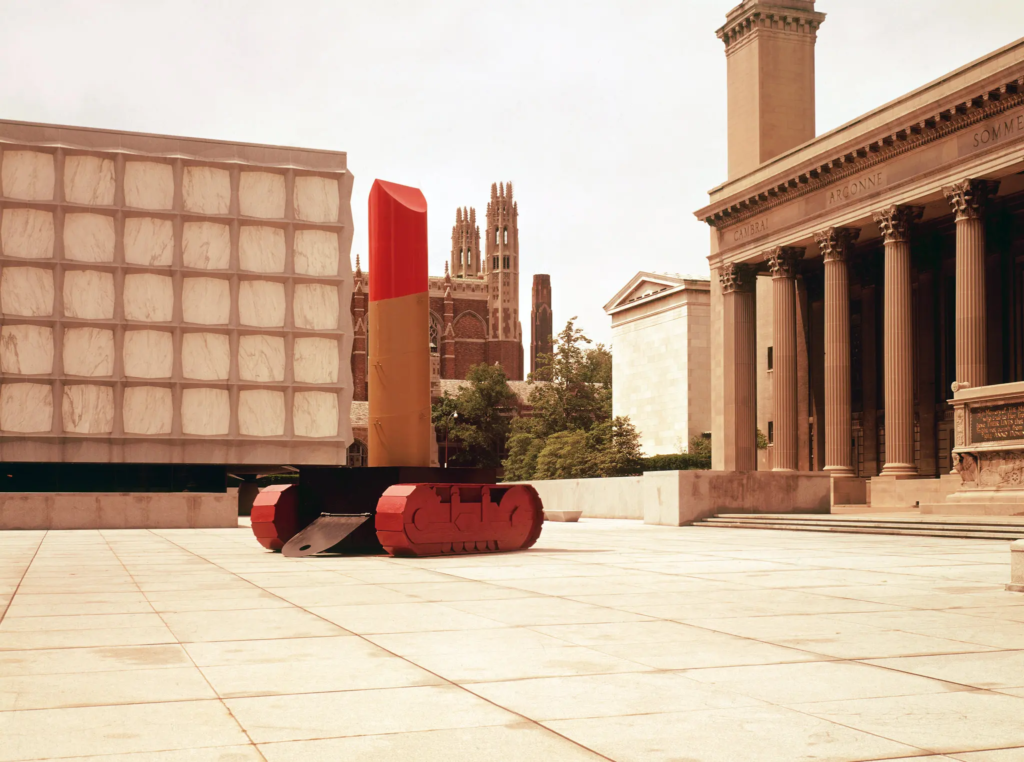
In this sculptural work by Claes Oldenburg, the artist chose to illustrate an anti-war message, and align himself with the peace movement. Combining the masculinity of the war machine , with the femininity of the lipstick was meant to illustrate the absurdity of American aggression. Originally, the lipstick tube was made with fabric that inflated. The sculpture, standing 24 feet high, was made in collaboration with an architecture student and stood at Yale University’s Beinecke Plaza. Later it was taken down and reinstalled outside the Morse College building, with a metal painted lipstick tube. The final work today is made from corten steel, aluminum, cast resin, and polyurethane enamel.
For more examples see our guide on Pop Art Artwork.
Pop Art vs. Abstract Expressionism
Pop art and Abstract Expressionism occurred during the same period. Both movements challenged what was traditionally regarded as art. Pop art is full of recognizable consumer images that draws the viewing public in with familiarity. In contrast, Abstract Expressionism is void of immediate subject matter beyond the feelings of the artist. In this way, Pop Art is in direct opposition and a reaction to Abstract Expressionism.
Pop Art vs. Contemporary Art
Contemporary art followed the Pop art movement. Like Pop art, contemporary art is not defined by traditional art approaches. Pop art has a distinctive style to it, with some regional difference. Contemporary art is global and cannot successfully be defined. It is continually evolving with new styles and advancement, particularly in the digital age. The art is not commercial driven.
For more information, see our full guide on Pop Art vs. Contemporary Art.
